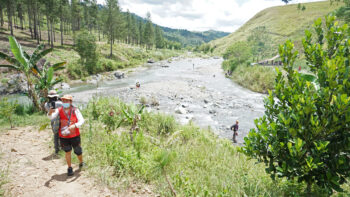Zamboanga City’s hard road to recovery from weeks of urban fighting between Muslim rebels and government troops has been delayed by heavy rains that shut down the city yesterday (Oct. 8), cancelling flights and closing schools. However long the recovery takes, and whatever shape it assumes, the assault by some elements of the Moro National Liberation Front (MNLF) that began September 9, forcing more than 100,000 people from their homes, has clearly shifted the landscape for peace in Mindanao.
To understand how requires historical context.The strength of Spanish influence on “Asia’s Latin City” is demonstrated by the language spoken: Chavacano is a creole language based on Spanish, a result of the Spaniards’ long presence sheltered by Fort Pilar, confronting the power of the Sulu Sultanate in the Sulu Archipelago stretching out toward Malaysia from the Zamboanga peninsula. On the other hand, the city did for a time early in the American colonial era (1903-1913) serve as the capital of the “Moro Province,” administered separately from the rest of the Philippines.
Thus, the city is of great emotional significance both for Moros (and the armed Muslim separatist movements that have their roots in the late 1960s) and Christians (often called “settlers” despite having been present for centuries).
Predominantly Christian, some 22 percent of the city’s population is Muslim, with an increase in the past four decades as inhabitants of the Sulu archipelago migrated to the city to escape war and take advantage of the urban economy. For MNLF forces to declare their intent to raise their flag over city hall was deeply provocative; the fact that Habier Malik led the force meant that at least the leadership was ready to fight.
A charismatic follower of MNLF founding chairman, Nur Misuari, Malik is known as a warrior and has outstanding arrest warrants, including for the death of two American servicemen in a roadside bombing in 2009.
Zamboanga City officials (and the national government) wanted to avoid a reprise of the 2001 Cabatangan incident, when armed MNLF hostage takers were allowed to go free and retain their arms in return for the safe release of hostages.
In 1996, tens of thousands protested the Final Peace Agreement with the MNLF because the city had been included in the coverage of the Southern Philippine Council for Peace and Development, headed by Misuari.
Zamboanga City had again been a center of resistance to the 2008 MOA-AD since eight barangays were included in a list to be added to the Bangsamoro Juridical Entity (albeit after a plebiscite). The argument of officials was simple: the city voted overwhelmingly “no” in 1989 to inclusion in the first version of the Autonomous Region in Muslim Mindanao (ARMM). Again in 2001, a 95.1 percent “no vote” declined inclusion in a revised ARMM (supposedly pursuant to the 1996 Agreement).
It is in this light that we must view Nur Misuari’s demand that the Tripartite (MNLF, the government, and Organization of Islamic Cooperation [OIC]) Review of the implementation of the 1996 final peace agreement include yet another plebiscite throughout the entire territorial coverage of the original 1976 Tripoli Agreement.
While from Misuari’s point of view this is a reasonable demand, since the previous plebiscites had gone ahead over the objections of the MNLF, such a move would cause unrest in widespread areas of Mindanao such as Zamboanga City, raising the simple question: What part of “no” in two plebiscites is not understood?
As the 41st round of exploratory talks between the government and the Moro Islamic Liberation Front (MILF) get underway in Kuala Lumpur, the obvious question is what effects will the Zamboanga incident have on the long-term peace process? In the short term, there is none: the 40th round was completed while fighting raged in Zamboanga, and both negotiating parties are determined to continue down this path.
Yet even Celso Lobregat, the former mayor of (now Congressman from) Zamboanga, has raised the issue of how talks with the MILF relate to previous agreements with the MNLF. In July, he presciently warned in a speech: “To have an honorable, just, and lasting peace in Mindanao, we cannot simply have another peace agreement this time with the MILF without the inclusion and conformity of other stakeholders of Mindanao including Misuari’s MNLF.”
For its part, the government’s peace department, the Office of the Presidential Assistant on the Peace Process, has produced an elaborate account of attempts to reach out to Misuari through both the Tripartite Review Process (which has agreement on almost everything, with the plebiscite being a deal-breaking exception), and in the MILF process (Misuari was asked to nominate for the Transition Commission, but since he views the MILF peace process as illegal in the face of the 1996 FPA he declined). So, it is obvious that Nur Misuari personally will never conform to a peace agreement with the MILF.
But there are other elements to the MNLF with varied relations with Nur Misuari: some MNLF elements are formally set up to represent the MNLF as a whole, others are still within Misuari’s ambit but disagree both with his call for independence and with the assault on Zamboanga City, and other elements simply represent long-standing MNLF communities. There may be many disputes over how the Zamboanga incident unfolded, but one thing is clear: reinforcements and support from other MNLF did not arrive.
So, one element of inclusiveness in the peace process will be to involve the MNLF (taken broadly) in the political aspects of the peace process. Given their focus on the separate Tripartite Review Process, this will be difficult but must be accomplished. Somewhat easier is inclusiveness with respect to both Muslim and non-Muslim civil society organizations, which are entering into agreement on coordinating input into the Transition Commission as it drafts a proposed Basic Law for the Bangsamoro.
Another element of inclusiveness will be ordinary Mindanao stakeholders outside of the proposed Core Territory of the Bangsamoro, such as citizens of Zamboanga City. This violent incident will remind them of the possibility that a signed agreement will not lead to the cessation of violence and disarmament (as the 1996 FPA did not). The MILF negotiation process is still working on the Annex on Normalization, which will cover policing and decommissioning of the MILF. This Annex must carefully address several audiences, including MILF combatants being asked to transition into normal peaceful lives, and other Mindanao stakeholders being asked to believe this will indeed happen.
The Zamboanga City tragedy illustrates in miniature the challenges facing those constructing peace and development in Mindanao. How the government, the MILF, the MNLF, and the wider community respond to those challenges will be crucial in determining the trajectory of the next several years.
Steven Rood, The Asia Foundation’s country representative in the Philippines, has been directly involved in the formal peace process between the GPH and the MILF since 1999. He is now the Third Party Monitoring Team representative from the Foundation. He can be reached at srood@asiafound.org. Reproduction of this piece, first published in In Asia, a weekly insight from The Asia Foundation, 9 October 2013 (http://asiafoundation.org/in-asia/2013/10/09/zamboanga-tragedy-a-pivot-point-in-the-mindanao-peace-process/) is with the permission of Dr. Rood.







